Recipes
Pickles with Garlic, Scapes & Fennel
Lacto-Fermented Pickles with Garlic Scapes and Fennel (photo: Instagram)by Dori Fern
When I posted the above shot on Facebook with the caption “Mama’s First Pickles,” a friend expressed shock that I had never before then attempted to make these simple, sour treats at home. I am, after all, an avid and adventurous cook with Semitic, pickle-eating, roots who resides in Brooklyn, the locavore locus of do-it-yourselfness.
I have resisted making my own mainly because, unlike many foods and dishes I boldly believe I can improve on myself, I cannot imagine besting the Eastern European-style pickles I have most enjoyed. Growing up, that meant Ba-Tampte half sours, the brand favored by every self-respecting Jewish New Yorker. In my post-adolescence years, Guss’ pickles out of the barrel on the Lower East Side were a real revelation: garlic, half-sours, sours, sometimes tomatoes and always the addictive pickled mushrooms.
My pickle tastes have wandered in recent years. These days I tend to go for quick-pickled veggies decidedly not of the European variety, like sweet, hot and sour shredded cabbage and carrots. A perky topping, indeed, for tacos and Southeast Asian dishes. These I have made at home.
But last week at the market, I couldn’t get my mind off the classics of my youth. Ray had everything I needed to make a reinvented, neo-Brooklyn, version of the pickles I love: cute-as-a-button little kirbys, garlic scapes, new season garlic. And since I was buying the fennel for a salad, I decided to use the wild mane of fronds as a substitute for dill in my pickles.
This recipe on Food52 seemed perfect. I was curious about the lacto-fermentation process and liked the idea of watching it “cook” right on my countertop for a few days. My few tweaks: swapping in fennel fronds for dill, adding some dried pickling spices I had (which I wouldn’t bother with again) and adding both a few cloves of new garlic along with the scapes. I wouldn’t bother quartering, or even halving, Ray’s tiniest of kirbys next time. They’re small enough to leave whole.
They turned out bright and garlicky, sour and salty. Not exactly like the ones from my youth, but a transporting bite nonetheless.
Greatest Scapes
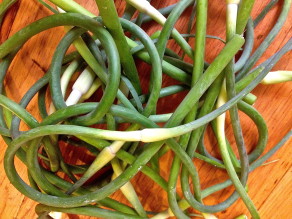
Image credit: Dori Fern
by Dori Fern
I have no idea how ramps became such a fanatically-trendy allium. For my money and tastebuds, I’ll take garlic scapes any day. You should, too. Scapes will last in your fridge forever-ish, they’re heartier and less costly than those precious wild onions (not that it’s a contest) and a few scapes go a long way. Plus, there’s an awful lot of easy and delicious things you can do with them.
These elegant-looking, curly garlic bulb tops have a fresh, herbaceous quality that’s lighter and less earthy than the bulbs, which makes scapes a fine add on to any variety of dishes or pan sauces or soups, imparting them with a bit of texture and zippy garlic flavor. My first piece of advice about using scapes: Get creative. I can’t imagine they’d hurt any savory dish you’d try them in. Some inspiration certainly can’t hurt though.
This was my breakfast yesterday…and the day before that:
Scrambled Eggs with Garlic Scapes, Tomato & Ricotta Salata
Serves 1
Sauté 3 finely-chopped garlic scapes in some butter or olive oil for about a minute, add 1/2 chopped tomato (or don’t), a pinch of paprika (or not), then add 2-3 eggs–depending on your appetite–salt & pepper to taste. Scramble soft then mix in some crumbled ricotta salata or feta or goat cheese…your choice.
Today for lunch I had this Fried Fish over Garlic Scape, Tomato and Baby Arugula Salad:
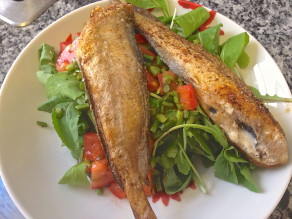
Fried Fish over Garlic Scape, Tomato and Baby Arugula Salad. Image credit: Dori Fern
Isn’t it pretty?
Sauté 4 chopped garlic scapes with the other 1/2 of the tomato from yesterday’s scrambled eggs. Cook a minute or so, then place over a bed of Ray’s baby arugula, adding salt and pepper to taste, a shpritz of lemon juice and a drizzle of good olive oil. The fried fish tops off the dish.
To make the fish: I used Ling Tail from Gabe the Fish Babe, a meaty, ocean-water fish that tastes like a cross between cod and fresh sardines, sold at the Park Slope Food Coop. Any white fish would do, as would fresh sardines. Dip fish in paprika and black pepper-seasoned flour, shake off the excess flour then pan fry til brown, about two minutes per side. Finish with salt.
The next thing I plan to make is this Garlic Scape with Almond Pesto from Dorie Greenspan (who also recommends adding the raw scapes to tuna or chicken–or, I would add, salmon or egg or, come to think of it, potato–salads).
The possibilities are endless but, alas, the season is not, so visit your nearest Bradley Farm stand this week and fill up a bag. You’ll thank me.
Soulful Swiss Chard
Swiss Chard, Onion & Cheese Frittata from Williams-Sonoma’s Taste blogby Dori Fern
If kale is today’s leafy green prom queen and spinach is the easy-to-love Everygreen, then think of swiss chard as the verdant, soulful-yet-populist artist type. With its buttery depth of flavor, chard is typically more supple than kale and has a bit more body than spinach.
June is the perfect time to enjoy swiss chard not only cooked, but also raw in salads. It’s a cinch to prep right now, since the stalks–which get bigger and tougher later in the season and are then best baked like slab bacon, cooked into lardons).
Swiss chard, in either the standard or red leafed variety, is my go-to weeknight veggie. Sometimes I’ll just saute it, with onion or a little garlic, but often I add it to make a simple one-dish meal. Think protein (ground or cubed meat, fish or beans), plus grain (pasta, farro, barley, etc, quinoa), plus green leafy vegetable (where the chard comes in) plus any tasty extras (maybe cheese or tomatoes or herbs or additional legume like peas or favas) and that’s dinner. And while it’s a familiar presence in Italian dishes, I often fancy using chard in Indian recipes.
When company’s coming, as a potluck take-along or when I’ve got time to spare on weekends, swiss chard dresses up real nice. Given its round, easy-to-love flavor and good body, chard makes a terrific star for tarts, gratins and frittatas.
Here are some tasty options to try, including this intriguing sweet tart by the inimitable David Lebovitz:
Alice Waters’ Swiss Chard Gratin (Serious Eats)
Goat Cheese, Chard and Herb Pie in a Phyllo Crust (The New York Times)
Swiss Chard Tart: Pasticcio di Bietole al Forno (Food Network)
Swiss Chard, Onion & Cheese Frittata (Williams-Sonoma’s Taste, pictured above)
And when I’m feeling particularly ambitious, I will make my daughter’s very favorite dish of all times, Malfatti a la Al di La. It will take some time and it’s impossible to overstate the need to thoroughly dry the chard, but the results are most rewarding when well done. On the other hand, you could always stick simpler swiss chard recipes at home and let Chef Anna Klinger–a longtime Bradley Farm customer–serve you the fancy stuff at their beloved Park Slope trattoria.
The Magic of Sorrel
Yotam Ottolenghi’s rhubarb, celery and sorrel salad Photograph: Colin Campbell for the Guardian
by Dori Fern
I fell in love with sorrel about a decade or so ago, when I came upon a recipe for Garden Vegetable Soup in a little-known cookbook called French Vegetarian Cooking that happened into my collection. Ray has sold sorrel, which is different from the hibiscus tea of the same name served mainly at Caribbean restaurants, for as long as I can remember. But until I stumbled on this soup recipe, I didn’t know what to do with it.
Sorrel’s distinctive, lemony flavor is wonderful if well-used, overwhelmingly sour if it’s not. The key is to balance sorrel’s built-in acidity with more lush ingredients. Yotam Ottolenghi, author of the wonderful and award-winning cookbook, “Jerusalem,” speaks to this point in “Sour Pour,” the piece — with recipes — he wrote for The Guardian website:
This startlingly sour leaf, if paired with more evenly balanced flavours, can turn even the most frugal of meals into something very special. As with lemon juice, the more sorrel you use, the more it has to be balanced with something sweet, starchy or creamy…
I’ve recently branched out from my one, go-to sorrel soup recipe. Last week I made the most incredible sorrel mayonnaise. Into a food processor I threw a handful of sorrel, a few big dollops of Hellman’s (I was in a rush to make lunch for my hungry son, but as food writer and Ray-regular Melissa Clark has pointed out , I’ve been known to make my own, too), 3-4 cornichons with a splash of their brine, plus a spot of Dijon, pinch of salt and some black pepper. I wasn’t measuring, but play around and taste for yourself. I mixed the mayo with oil-packed tuna, coarsely chopping in a couple more cornichons, then made the most perfect tuna melt, really, ever.
But still, that beloved Garden Vegetable Soup is my personal rite of spring. It’s like a Provençal Schav, the cold soup favored by Russian Jews (see “The Food Maven” and Grand Army Plaza Greenmarket regular Arthur Schwartz’s recipe here). The sourness of this vegetable soup, though, is buffered by spinach and all the greens are stewed to a comforting softness.
The recipe is a fine guide, but don’t let it limit you: any spring green I find at the market may find its way into the mix: beet greens (how anyone could throw away these sweetly tender tops, which I prefer to the beets themselves, is beyond me), garlic chives, spring onions, ramps — if that’s your thing — though they’re probably an overly costly addition to an otherwise humble soup. The one non-negotiable ingredient: sorrel.
Garden Vegetable Soup
Adapted from French Vegetarian Cooking by Paola Gavin
4 tbsp. olive oil
1 medium onion, chopped
2 garlic cloves, finely chopped
3 leeks, thinly sliced
3/4 pound spinach, shredded
1/4 pound sorrel, shredded
4 cups water (or good-quality chicken or vegetable stock)
salt
freshly ground black pepper
2 egg yolks, lightly whisked (optional)
4 slices/wedges good-quality multi-grain bread, toasted (and buttered, if you like)
1/2 cup freshly grated Parmesan cheese
Heat the olive oil in a large pot and cook the onion, garlic, leek, and celery over a moderate heat for 5 minutes. Add the spinach, sorrel, water or stock, and season with salt and pepper to taste. Bring to a boil and simmer for 20-25 minutes. If using egg yolks for added creaminess, whisk about a 1/2 cup of the hot broth into the yolks to temper, then return the yolk mixture into the soup.
Add one slice of toasted bread to each bowl, then ladle in the soup. Serve with grated cheese.
Nettle Recipes: What to Cook with this Prickly but Lovable Herb
photo from TheKitchn.comThe sting of raw nettles is definitely worse than its bite. Sure, you’ll want to protect your hands when handling raw nettles, but don’t be afraid of this fleeting, springtime flowering plant. A quick dunk in hot water (or any hot liquid) softens those stingers straightaway. And not only is nettle quite easy to cook (most anything you’d do with cooked spinach–which has a similar taste–can be made with nettle), it’s also incredibly nutritious and delicious in equal measure. Rich in vitamins A, C, iron, potassium, manganese, and calcium, in the peak of the season, nettle also purportedly contains up to 25% protein.* Some use histamine-rich nettle as a remedy for seasonal allergies, but most sources suggest using it in tincture form or freeze dried to get those benefits, which may be lost in the cooking process.
Nettle has long been a popular edible plant in Northern and Eastern Europe and in India. The English, Scottish and Czech even have a long tradition of making nettle beer (see recipe below). Visit Ray’s farm stand in May when he’s rich with the stuff. Here are some tasty nettle recipes to whet your appetite.
Nettle Soup (The Kitchn)
Stinging Nettles: 8 Recipes for Spring Cooking (The Kitchn)
Nettle Pasta (101cookbooks)
Hugh Fearnley-Whittingstall’s Favorite Nettle Recipes (The Guardian)
Make your own nettle beer (selfsufficientish.com)
*Source: Wikipedia
Slab Bacon – Great Recipes to Try

If strip bacon is trendy and ubiquitous, then slab bacon is strip’s heady, lesser-seen, deeper sibling. In his Bacon 25 Ways piece in last October’s NY Times, Mark Bittman calls this meaty cut both more flexible form and (typically) better quality.
We all know that if Ray’s selling bacon, whatever the cut, it’s going to be primo quality. But when he’s selling slab, don’t miss out on the opportunity to take some of this special stuff home to try.
Get inspired with even more recipes to get your culinary juices sizzling:
50 Things to Make With Bacon (FoodNetwork.com) – The following ideas would be our picks for Ray’s bacon, even though they don’t all specifically call for slab: Numbers 11 (Bacon Quiche, pictured above), 22, 28, 30, 31, 33-37, 43
Loa Ortiz tipped us off to this Epicurious recipe she recently discovered: “I can’t stop making this! Use Ray’s slab bacon [and, when they’re in season, his mustard greens] for a really delicious smoky flavor. There’s minimal cooking required, strong flavors that balance each other out, nothing overpowers anything else, and it’s bright, fresh and healthy but still rich and satisfying.”
* Loa’s recipe adaptations and notes:
- In place of the onion: Use 1 large shallot, cut in half-moon slices, not finely chopped.
- If your mustard green is young and tender, no need to remove the ribs.
- Doubling the recipe is highly advisable.
Ray’s Turnips in the New York Times
Greenmarket customer and food writer Melissa Clark discovered Ray’s turnips and created this beautiful raw salad with arugula and prosciutto. Read the full article in her New York Times column, A Good Appetite.
photo © Andrew Scrivani for The New York TimesShaved Turnip Salad With Arugula and Prosciutto
Published: New York Times, November 28, 2011
Time: About 10 minutes
4 teaspoons red wine vinegar
1/4 teaspoon fine sea salt
2 teaspoons honey
1/4 cup extra virgin olive oil
Pepper
4 small turnips, about 5 ounces, peeled
8 cups arugula, wild if possible
4 ounces thinly sliced prosciutto, torn into bite-size pieces
1. In a small bowl, whisk the vinegar and salt until the salt dissolves. Whisk in the honey, oil and pepper.
2. Using a mandoline or sharp knife, slice the turnips into paper-thin rounds. In a large bowl, combine turnips, arugula and prosciutto. Toss with the dressing. Taste and adjust seasonings if necessary.
Yield: 4 servings.
Bradley Farm Spareribs with Sweet-Sour Balsamic BBQ Sauce
Brooklyn customer, Heather T. made the sweet-sour balsamic BBQ sauce from this NY Times article with Ray’s spareribs and says they were outstanding!
Here are the details:
No need for the elaborate cooking methods in the article recipe, just rub the ribs with salt and pepper and roast them at 350 for about 1 hour and a half, turning every 30 minutes. The meet is tender and pulling away from the bone when they’re done.
In the meantime make THE SAUCE. Slather it on the cooked ribs and pop them back in the oven for 10 minutes more. Serve with the extra sauce and plenty of napkins unless you prefer finger licking :) Goes great with some mashed Bradley Farm potatoes!
Balsamic Glazed BBQ Sauce:
1 cup balsamic vinegar, or to taste
1 cup ketchup (didn’t have any so I used some tomato paste and added a little extra h20)
6 oz. your favorite beer
1/4 cup honey
3 tablespoons grainy mustard
1 tablespoon molasses
1 1/2 teaspoons Worcestershire sauce
1 teaspoon Tabasco sauce, or to taste
1/4 cup dark brown sugar, or to taste
1/2 red onion, diced
1 large clove garlic, minced
Salt
Place the balsamic vinegar in a large nonreactive saucepan. Bring to a boil over medium heat and cook until reduced by a third. Add the remaining barbecue sauce ingredients with 1/4 cup water, bring back to a boil, then reduce the heat to low and simmer until thick, 30 to 40 minutes. If the sauce starts to thicken too much, add a little water. The sauce should be highly seasoned; adjust to taste by adding vinegar, brown sugar or salt.
New Winter Product: Frozen Cheese Pumpkin
Ray has a great new product this winter, frozen cheese squash, available in 16 oz packages. Use it for making soup or baking pies, cookies, muffins – any recipe that calls for canned pumpkin will be healthier, tastier and even look better if you use this.
Here’s an easy recipe to try (thanks, Risa):
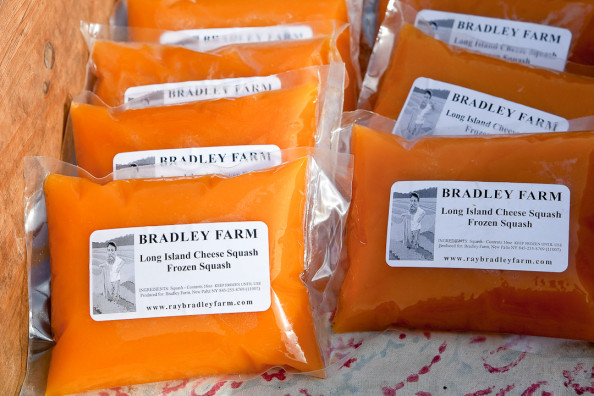
photo by Etienne Frossard
Cheese Squash Muffins
1 1/2 c. of flour
1 tsp. baking powder
Whisk together in a bowl.
1 c. Ray’s squash puree
1/3 c. veg. oil
1/2 c. sour cream
1 1/4 c. sugar
1/2 tsp. baking soda
1/2 tsp. salt
1/2 tsp. cinnamon
1/8 – 1/4 tsp. nutmeg
Whisk together in a separate bowl until combined, then add flour mixture and stir until just combined (don’t overmix).
Add:
1/2 c. chopped walnuts
1/4 – 1/2c golden raisins (chopped if large raisins)
Spoon mixture into muffin tins lined with paper muffin cups.
1 tbsp sugar
1/2 tsp cinnamon
Mix together and sprinkle on top of muffins.
Bake in a preheated oven of 350 degrees for 30 – 35 minutes (check at 25 mins) until golden brown and toothpick comes out clean.
Cool in pan on rack for 10 minutes. Remove from pan and cool on rack.
Simple Seasonal Sides – Using Ray’s Produce
Seasonal vegetable sides that are perfect for Thanksgiving:
Mash Carola Potatoes
Ray recommends no peeling. Cut and put in water along with 1 clove of garlic. Cook till done, mash with butter, salt, pepper with cream or milk to taste.
Three squashes: Delicata, Butternut, Buttercup
(Ray’s personal favorite this year is buttercup) You can cut in half (the long way) and scoop out seeds. Place on shallow baking pan, in a water bath, with salt and pepper, 350 degrees till soft. Scoop out, can puree with butter, salt and pepper.
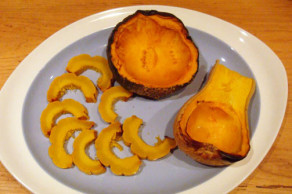
Three Squashes: Delicata, Buttenut, Buttercup
Delicata Squash
Wash skin well, cut in half the long way, scoop out seeds, cut again horizontally in thin slices (half moons). Place on cookie sheet with olive oil, salt and pepper, 400 degrees till golden brown.
Butternut Squash
This is Mark Bittman’s from NYTimes 11.17.10 and sounds too good not to mention-
Raw Butternet Nut Squash with Raisins and Ginger – Take squash – peel, seed and grate- combine with 1/2 cup raisins, 1/4 cup vegetable oil, 1-2 tablespoons sherry vinegar, 1 tablespoon minced fresh ginger in a bowl, salt and pepper, toss and serve. (Can make in advance and refrigerate)
*For those making a gratin, try mixing potatoes and thin slices of butternut. It’s a great combo.
Cheese Pumpkins
For all baking recipes (bread, pie, muffins, soup) this is the pumpkin to use. It also freezes well. Cut in half, scoop seeds, bake in 350 oven till soft. Scoop out, let liquid drain.
Cape Cod Turnips
You cook just like a potato. These you must peel, and then mash them like you would a potato.
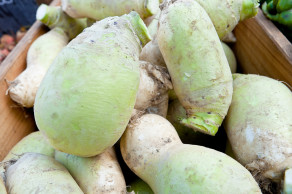
Cape Code Turnips (raw, at the market)
Celery Root
Boil and puree in blender with liquid (veg or chick stock), you can add cream if you like. Or boil and mix with potato in a mash.
*You can also do a roasted medley of turnips, any of the squashes and celery root. Cut into strips or small pieces and roast on a cookie sheet with olive oil, salt and pepper.
Creamed Onions
Don’t peel – salt, pepper, roast in oven, oil and a little water to make moist – 350 oven on sheet pan. When soft (15 min) take out, take off bottom and skin. Put cream or stock (can be done the day before).
Bolero Carrots
No peeling, cut (same size), put in enough water just to cover the carrot, cook, salt and pepper.
Sunchokes
No peeling, bake like a potato in oven, olive oil, a little water in the bottom. Also good raw in salads, sliced thin.